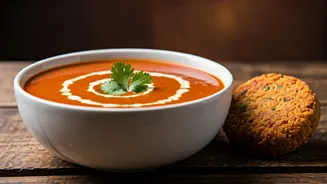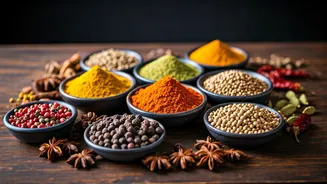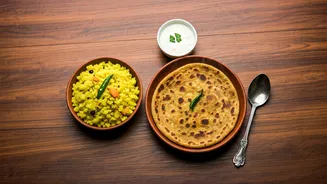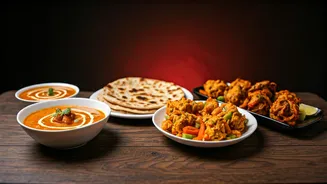A Culinary Heritage
Indian cuisine is far more than just food; it's a reflection of the nation's rich history, diverse cultures, and age-old traditions. The origins of Indian cooking
can be traced back thousands of years, with influences from various empires, including the Mughals, Persians, and British. These interactions led to the fusion of flavors, techniques, and ingredients, creating the incredible culinary tapestry we know today. The use of spices is one of the most distinguishing features of Indian food. These are not merely seasonings; they are carefully blended to add depth, complexity, and medicinal properties. Each spice has its own history and significance, adding to the unique character of Indian cooking. Furthermore, regional variations play a massive role, with each state boasting its own unique flavors and cooking methods, and reflecting the diverse geography and climate.
Spices: The Soul
Spices are the heart and soul of Indian cooking, adding both taste and nutritional value. The range of spices used is vast, including turmeric, cumin, coriander, cardamom, cloves, cinnamon, and many more. Turmeric, known for its vibrant yellow color and anti-inflammatory properties, is a cornerstone of many Indian dishes. Cumin and coriander add an earthy and aromatic depth, while cardamom and cloves contribute warm, sweet notes. The art of spice blending is crucial, with each blend having its specific purpose and flavor profile. Garam masala, a blend of roasted spices, is a prime example of the importance of these carefully created mixes. The use of spices is also influenced by regional preferences. For example, in the south of India, you'll find more use of curry leaves and mustard seeds, whereas the north might use more garam masala and nuts.
Regional Delights Abound
India's regions offer a kaleidoscope of tastes, ranging from the fiery curries of the south to the rich, creamy dishes of the north. In the north, you'll encounter tandoori dishes, such as tandoori chicken, and flavorful gravies often made with tomatoes, onions, and cream. Popular dishes include butter chicken, palak paneer, and various types of biryani. Heading south, you'll find dishes characterized by coconut milk, tamarind, and the extensive use of lentils and rice. Popular options include dosa, idli, sambar, and a wide array of seafood preparations. The eastern part of India has a penchant for sweets, alongside a wide range of seafood and rice dishes. Bengal is known for its fish curry, rosogolla, and mishti doi. The western region has an abundance of vegetarian options. Gujarat is known for its sweet and savory thalis, and Maharashtra for its spicy curries like pav bhaji and vada pav.
Cooking: Techniques, Traditions
Indian cooking is not just about the food but also about the techniques and traditions passed down through generations. Grinding spices fresh using a mortar and pestle is a time-honored practice that enhances the flavors, as is the use of a tandoor, a traditional clay oven, for grilling and baking. Slow cooking is common, allowing flavors to meld and develop over time. This method adds depth to curries and stews. Frying is another key technique, used for creating crispy snacks such as samosas and pakoras. Every Indian family has its unique recipes and methods, making each meal a celebration of heritage. From preparing the perfect chapati (Indian flatbread) to the careful balance of spices in a curry, each step is taken with care and reverence. The concept of 'cooking with love' is ingrained in the practice.
Essential Indian Ingredients
Indian cuisine is defined by certain key ingredients. Rice, the staple grain, comes in numerous varieties such as basmati, brown, and many local kinds. Lentils (dal) are also fundamental, providing protein and texture in various dishes like masoor dal, chana dal, and urad dal. Dairy products are integral, with ghee (clarified butter) adding richness and flavor, and yogurt used in curries, marinades, and raitas. Fresh vegetables like onions, tomatoes, potatoes, and spinach are used extensively. Nuts and seeds, particularly cashews, almonds, and sesame seeds, add texture, flavour, and nutrition. Fresh herbs like cilantro, mint, and curry leaves enhance the aroma and freshness of the food. These elements work in harmony to produce the distinctive flavors that make Indian cuisine so well-loved.
Celebrating Indian Food
Indian cuisine offers an exciting journey through flavor, technique, and tradition. Through the spice-filled heartlands, the regional variations and culinary practices, it showcases how cooking can be a celebration of culture. Whether it is enjoying a spicy curry, a flavorful biryani, or a sweet dessert, Indian food provides an opportunity to experience India's rich heritage. Exploring this cuisine is not just about taste but also about embracing the storytelling around it, from the origins to the preparation. Each bite is a story, making Indian food a culinary experience filled with love, history, and a touch of magic. It provides a unique lens into understanding India's diverse and vibrant cultures.













